
All images © by Roberto Piperno, owner of the domain. Write to romapip@quipo.it.
Notes:
Page added in October 2025.

All images © by Roberto Piperno, owner of the domain. Write to romapip@quipo.it.
Notes:
Page added in October 2025.
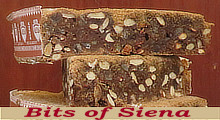 Piazza del Campo
Piazza del CampoYou may wish to take a walk along the main streets of Siena first.
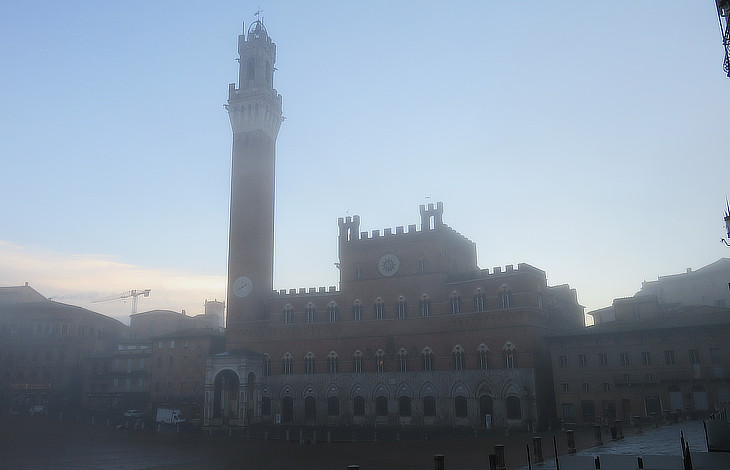
Piazza del Campo (January - early morning)
Betweene
the said gates, as it were in the center of the City, lies
a most faire Marketplace, in the forme of an Oyster,
and lying hollow as the shell thereof is. And there is
a stately Pallace of the Senate, built when the Citie was
free.
Fynes Moryson - An Itinerary: Containing His Ten Years Travel Through .. Italy (in 1594)
The Palazzo Pubblico, with its lofty tower Del Mangia, stands in the Piazza del Campo, a large open space more nearly resembling the form of an escalop shell than anything else to which it has been compared. Its entire circuit is said to be 1000 feet; it is sloped like an ancient theatre for public games, and its artificial soil is supported by strong walls. It is difficult to imagine anything more perfectly in accordance with the idea of republican greatness than the aspect and arrangement of this forum; it was the scene of many popular tumults during the middle ages, and derives its name, "del campo" from a passage of Dante.
John Murray - Handbook for travellers in Central Italy - 1843
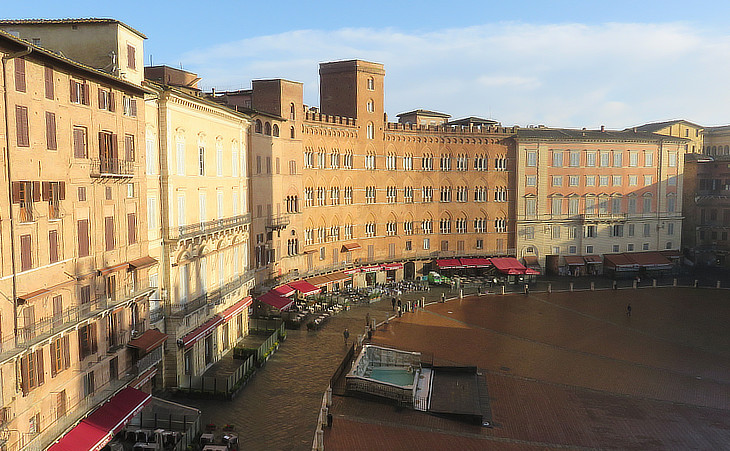
Northern part of Piazza del Campo with Palazzo Sansedoni seen from Palazzo Crocini
The Piazza or Market-place is compassed about with good buildings, and for the figure of it not unfitly resembled to a cochle or scallop-shell. This fancy had they who paved it, for on one side, viz. that next the Palace, they have placed the figure of the heel of a cochle-shell made in stone, and from thence have drawn rayes or ribs of stone to the edges round.
John Ray - Observations topographical, moral, and physiological: published in 1673.
The great square is hollow like a boat or scallop-shell; it may be easily filled with water from its fountains, to represent the naval fights, according to the custom of the Romans. The houses round it are all uniform, with piazza's under them to cover the people from sun and rain.
Thomas Nugent - The Grand Tour - 1749
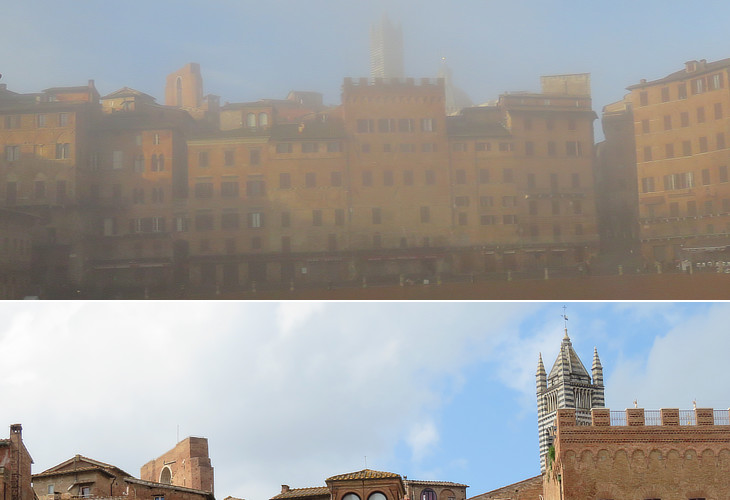
Southwestern part of Piazza del Campo and behind it the Cathedral and its planned enlargement: (above) early morning in January; (below) August
The Magistrate sets a price upon every thing to be sold
in the market, neither dare any man sell ought, before
his price be set; and upon the Butchers stals, a bill is
set of the prices at which they must sell their meat, so
as a stranger cannot be deceived. Fynes Moryson
About this market-place (for so it is) are many fair palaces, though not built with excess of elegance.
John Evelyn - Diary and Correspondence related to his stay in Italy in 1644
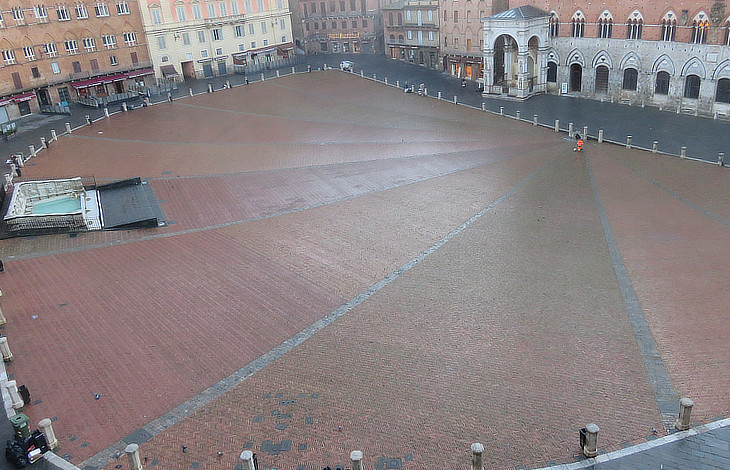
Piazza del Campo seen from Palazzo Crocini
On the other side is the Palazzo Pubblico, or Court of Justice, well built a la moderna, of brick; indeed the bricks of Sienna are so well made, that they look almost as well as porphyry itself, having a kind of natural polish. (..) The piazza compasses the facciata of the court and chapel, and, being made with descending steps, much resembles the figure of an escalop-shell. The white ranges of pavement, intermixed with the excellent bricks above mentioned, with which the town is generally well paved, render it very clean. Evelyn
(1873) The Piazza, being built on the side of a hill - or rather, as I believe science affirms, in the cup of a volcanic crater - the vast pavement converges downwards in slanting radiations of stone, the spokes of a great wheel, to a point directly before the Palazzo, which may mark the hub, though it is nothing more ornamental than the mouth of a drain.
Henry James - Italian Hours - publ. 1909
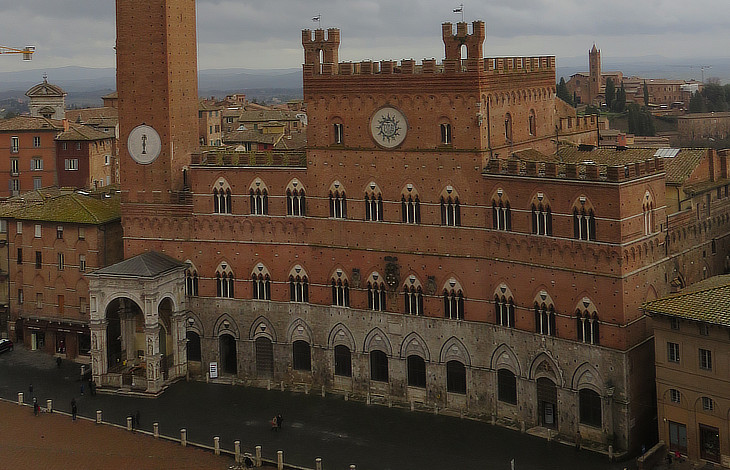
Palazzo Pubblico seen from Palazzo Crocini (the image used as background for this page shows the radiant sun surrounding the letters IHS, the symbol of St. Bernardino da Siena)
Florence, Pisa, and Sienna never contained more inhabitants or displayed greater resources than when warring upon each other, and marching hostile legions to each other's gates. This remark, applicable to the other Italian republics of the same period, and indeed to those of both ancient Greece and Italy, proves that the agitations of a commonwealth are neither so dangerous to public happiness nor so destructive of private felicity, as the advocates of monarchy wish to persuade the world. The truth is, that tide of prosperity which has left so many traces behind, not only in the cities which I have just mentioned, but in almost every town in the northern parts of Italy, was the effect of republican industry; and most of the stately edifices which still adorn these cities, whether public or private, sacred or profane, were raised by republican taste and munificence.
John Chetwood Eustace - Classical Tour of Italy in 1802 (publ. 1813)
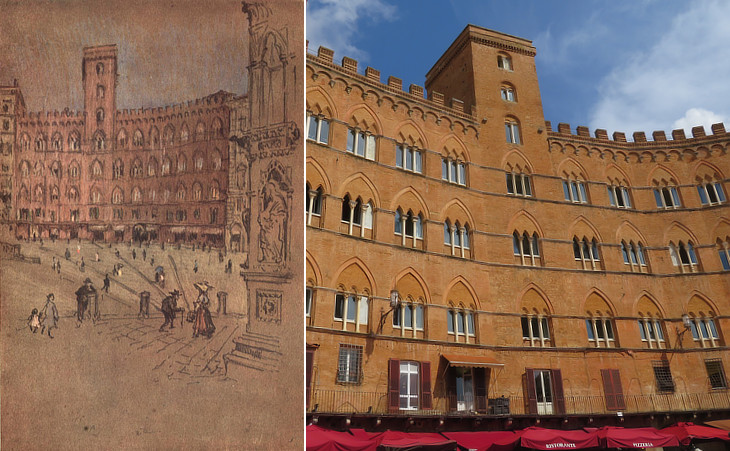
(left) "The Red Palace", i.e. Palazzo Sansedoni and Cappella di Piazza, illustration by Joseph Pennel for "Henry James - Italian Hours - 1909"; (right) Palazzo Sansedoni
The great monument stands on the lower side and might seem, in spite of its goodly mass and its embattled cornice, to be rather defiantly outcountenanced by vast private constructions occupying the opposite eminence. This might be, without the extraordinary dignity of the architectural gesture with which the huge high-shouldered pile asserts itself.(..) The gigantic houses enclosing the rest of the Piazza took up the tale and mingled with it their burden. "We are very old and a trifle weary, but we were built strong and piled high, and we shall last for many an age. The present is cold and heedless, but we keep ourselves in heart by brooding over our store of memories and traditions. We are haunted houses in every creaking timber and aching stone." Such were the gossiping connections I established with Siena before I went to bed. Henry James
Palazzo Sansedoni was given a new design in Gothic style in the XVIIIth century.
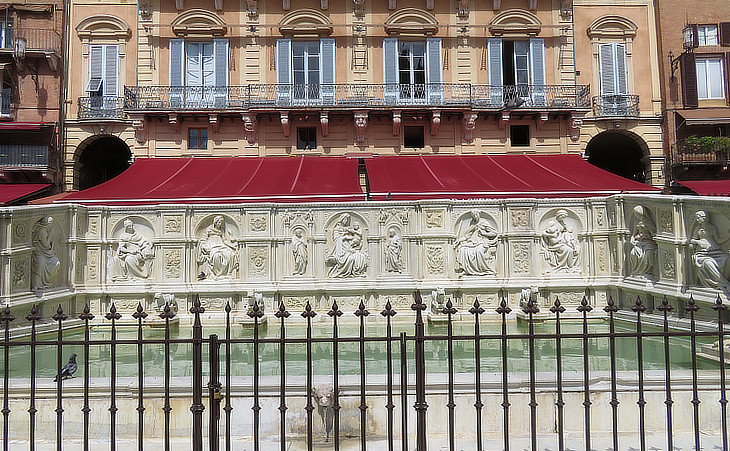
Fonte Gaia and behind it the XVIIIth century fašade of Casino dei Nobili
On the edge of the piazza is a goodly fountain beautified with statues, the water issuing out of the wolves' mouths, being the work of Jacobo Quercia, a famous artist. Evelyn
There is also a very fine fountaine standing in a large
place of the Citty, about which is carved 7 Wolfes in
Marble, out of the mouth of which the water runs.
Francis Mortoft - Journal of his travels in France and Italy in 1659
The Fountain, called the Fonte Gaia, gave the name "della Fonte" to Jacopo della Quercia, who executed the marble bas-reliefs, representing various subjects of Scripture history, now unfortunately damaged. The subterranean aqueducts which supply it occupied two centuries in their construction, and are fifteen miles in length. Murray
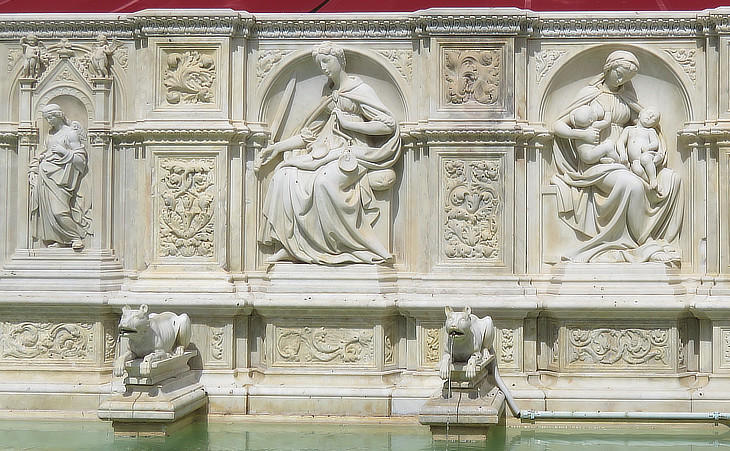
Fonte Gaia: reliefs portraying Justice and Charity
Jacopo's design consisted of a three-sided marble parapet; the central and longest was divided into nine niches, containing statues of the Madonna and Child, and the seven theological virtues, while the other two were decorated with bas-reliefs representing the Creation of Adam, and the Expulsion from Paradise. Below, from the surface of the basin, rose marine animals bearing children on their backs, and wolves, and dolphins, from whose mouths issued jets of water. Though now sadly mutilated and worn by time, its novelty of design and beauty of general effect make Fonte Gaja one of the model fountains of the world. Its statues have the grace of line characteristic of Quercia's best works, and their draperies fall in those peculiarly heavy snake-like folds which he so much affected.
Charles C. Perkins - Tuscan Sculptors - 1864
The white marble which was used for this fountain and for most of the statues which decorate the fašade of the Cathedral was quarried in the proximity of Siena and it did not stand the test of the time. In 1868 Tito Sarrocchi, a local sculptor, was asked to restore and in many cases entirely replace the worn out reliefs by Jacopo della Quercia. Some of the original reliefs can be seen at Ospedale di Santa Maria della Scala (it opens in another window).
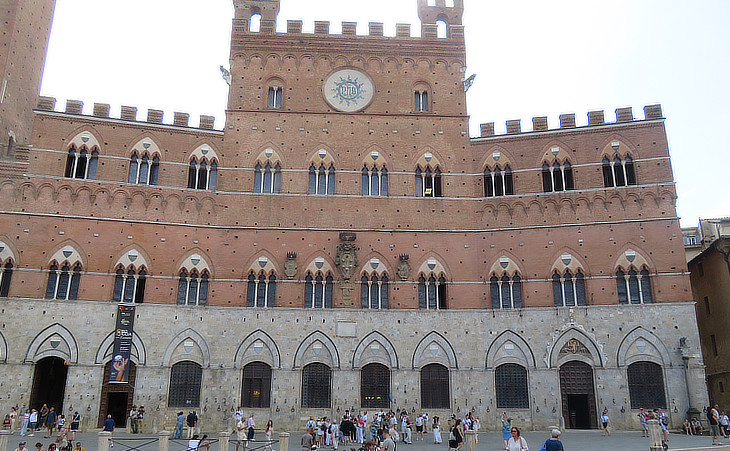
Palazzo Pubblico (see the coat of arms of Cosimo I de' Medici at the centre of the fašade)
The grand piazza is sloped, like an ancient theatre, for public games; and, like that, it forms the segment of a circle, in the chord of which stands the Palazzo Pubblico. This palace is a work of different dates and designs, and parcelled out into very different objects; such as the public offices, the courts of law, the theatre, and the prisons.
Joseph Forsyth - Remarks on Antiquities, Arts, and Letters in Italy in 1802-1803
The Palazzo Pubblico was begun in 1295 and finished in 1327, from the designs of Angelo and Agostino da Siena; it is now converted into public offices, courts of law, and prisons. Murray
The top floor of the two wings was added in 1680-1681. Today the building houses the main offices of the Comune di Siena.
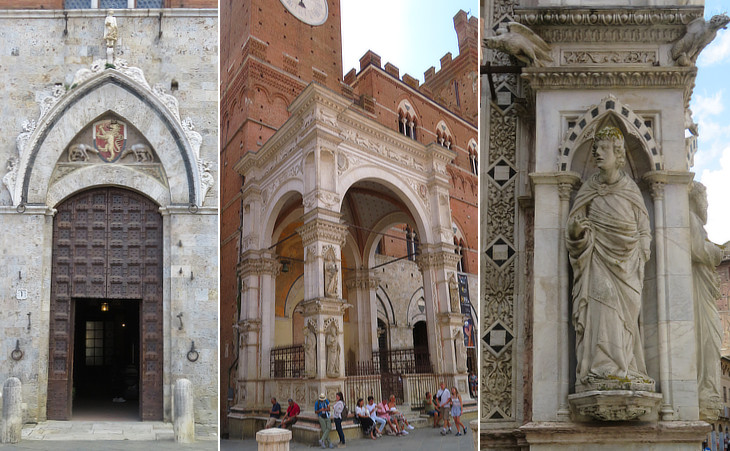
(left) Entrance to the offices of the "Comune di Siena"; (centre) Cappella di Piazza (see other images of it); (right) St. Thomas the Apostle, by Mariano di Angelo Romanelli (1378 - copy)
At the entrance of this tower is a chapel open towards the piazza, of marble well adorned with sculpture. Evelyn
The beautiful chapel which projects from the fašade beneath the tower commemorates the deliverance of Siena from the plague in 1348, but its upper part was redesigned in Renaissance style by Antonio Federighi, a local sculptor and architect in 1463-1468.
At Sienna there are many plain brick towers erected for defence, while this was a free state. The highest is called the Mangio, standing at the foot of the piazza which we went first to see after our arrival. Evelyn
We ascended the Tower called Torre di mangio from whence we had a fair prospect of the whole City, which runs out into 3 angles. The walls enclose much void ground, which is made of for Gardens and Vineyards. Ray
The inhabitants are very proud of the square tower, which has been recently increased in height, by projecting stone turrets, which make it larger at top than at bottom. Peale
The tower, called della Mangia, begun in 1325, is said to have been greatly admired by Leonardo da Vinci, who came here to examine its construction in 1502. Murray
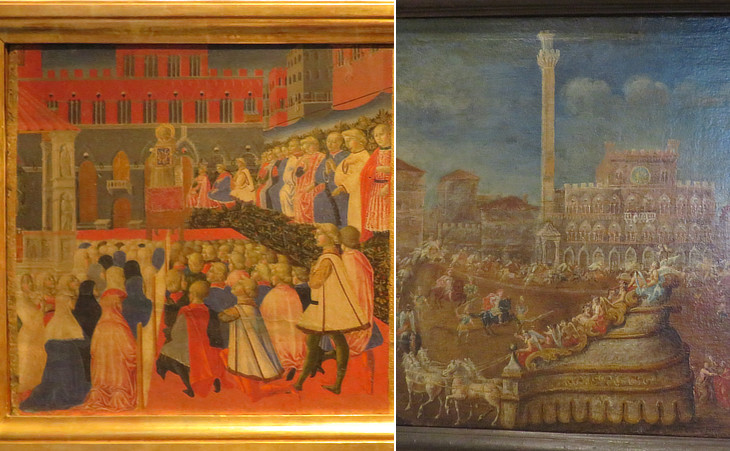
Palazzo Pubblico - Museo Civico: (left) St. Bernardino preaching in Piazza del Campo (ca 1470) by Neroccio di Bartolomeo de Landi; (right) XVIIIth century depiction of a major celebration in Piazza del Campo
On the first of July, and the fifteenth of August, they divert themselves here with horse-races. Nugent
The Vergine Assunta, being the patroness of Siena, collects here in August all the neighbours that love either masses or debauchery. (..) On this occasion the horse-races of the piazza seemed to revive, among the different wards of the city, the same rivality that prevailed in the four factions of Rome. Every soul in each ward was a party engaged in the same cause, and trembling for the glory of the same horse. At the close of the race all was riot and exultation. The victorious ward tore their jockey from his saddle, stifled him with kisses, and bore him off in triumph to the wine-flask.
Most cities in Italy are split into little sections which may sometimes unite, but which more readily repel. The strongest bond of union among Italians is only a coincidence of hatred. Never were the Tuscans so unanimous as in hating the other states of Italy; the Senesi agreed best in hating all the other Tuscans; the citizens of Siena, in hating the rest of the Senesi; and in the city itself the same amiable passion was subdivided among the different wards. Forsyth
It is now the scene of the annual horse-race, called the Palio, which takes place on the 15th August, and is contested by the several wards of the city with a spirit of rivalry which recalls the factions of ancient Rome. Murray
Piazza del Campo was (and still is) the very heart of Siena; all major events took place there. Learn more about the Palio.
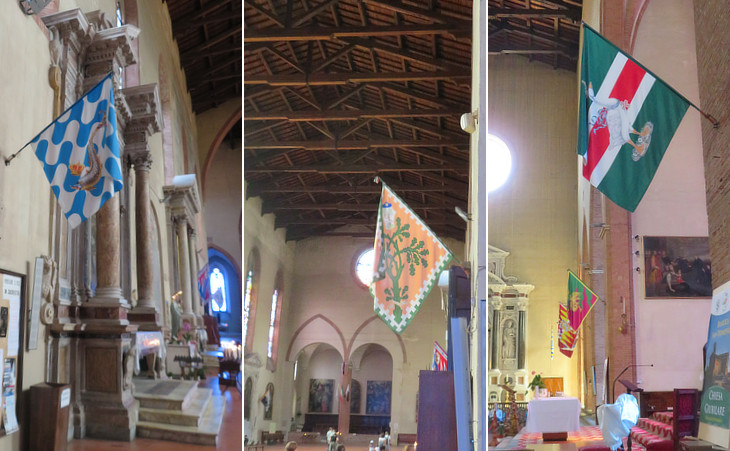
S. Domenico - Interior: flags of Onda (Wave), Selva (Wood) and Oca (Goose)
I have fond reminiscence of the year, the only year, at which I was present at the Palio, the earlier one, the series of furious horse races between elected representatives of different quarters of the town taking place toward the end of June, as the second and still more characteristic exhibition of the same sort is appointed to the month of August; a spectacle that I am far from speaking of as the finest flower of my old and perhaps even a little faded cluster of impressions, but which smudges that special sojourn as with the big thumb-mark of a slightly soiled and decidedly ensanguined hand. For really, after all, the great loud gaudy romp or heated frolic, simulating ferocity if not achieving it, that is the annual pride of the town, was not intrinsically, to my view, extraordinarily impressive - in spite of its bristling with all due testimony to the passionate Italian clutch of any pretext for costume and attitude and utterance, for mumming and masquerading and raucously representing; the vast cheap vividness rather somehow refines itself, and the swarm and hubbub of the immense square melt, to the uplifted sense of a very high-placed balcony of the overhanging Chigi palace, where everything was superseded but the intenser passage, across the ages, of the great Renaissance tradition of architecture and the infinite sweetness of the waning golden day. The Palio, indubitably, was criard - and the more so for quite monopolising, at Siena, the note of crudity; and much of it demanded doubtless of one's patience a due respect for the long local continuity of such things; it drops into its humoured position, however, in any retrospective command of the many brave aspects of the prodigious place. Not that I am pretending here, even for rectification, to take these at all in turn; I only go on a little with my rueful glance at the marked gaps left in my original report of sympathies entertained. James
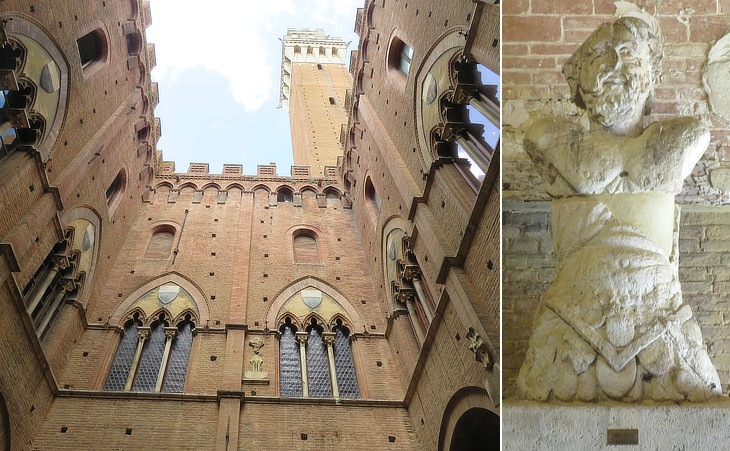
Palazzo Pubblico: (left) Cortile del PodestÓ; (right) remains of a statue which struck the hours
In the front of the Pallace is a statua of mixt mettall, vulgarly called di bronzo, which seemes to bee apparelled,
having on the head a broad hat and this statua strikes the
houre of the clock. Moryson
You have but to walk into the Palazzo Pubblico really to feel yourself a thrifty old medievalist. The state affairs of the Republic were formerly transacted here, but it now gives shelter to modern law-courts and other prosy business. James
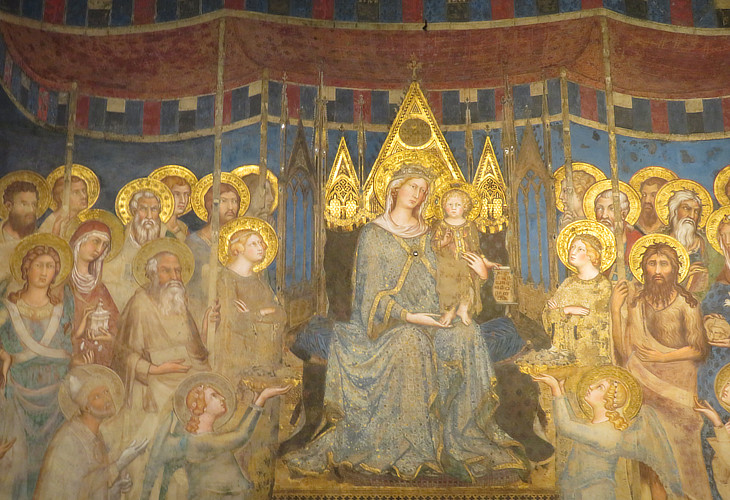
Palazzo Pubblico - Sala del Mappamondo or del Gran Consiglio: MaestÓ by Simone Martini (see other paintings by Martini at Orvieto)
The principal chambers of this curious building, the municipal palace, were decorated by all the best painters of Sienna, when Sienna was the seat of the arts, and her artists the most celebrated and excellent in the world: they were the rude precursers of more modern excellence. Peale
The Sala del gran Consiglio contains the immense fresco of the Madonna and Child with saints under a baldacchino, the poles of which are held by the apostles and patrons of the city, by Sermino di Simone, in 1287, retouched by Simone Memmi (di Martino) in 1321. Murray
Simone is obviously the follower of the purely Siennese manner improved by Duccio; and this is clear from the earliest of all his frescos. The Hall of the Palazzo Pubblico at Sienna is adorned with a wall picture enclosed in a border of medallions and shields, bearing the arms of the Comune and people. It is a vast piece whose total appearance leaves the impression of a tapestry or of a magnified miniature. The Virgin, wearing a diadem over her veil of blue, sits on a throne and gracefully calls attention by a gesture of her right hand to the infant Saviour standing on her knee and supported on her left arm. Her ample dress, minutely engraved with golden arabesques, luxuriously and somewhat studiously clothes a form more feminine and elegant than majestic. A certain affectation clings to her and is perceptible in the movement of the frame, as well as in the action of a beautiful hand. The guardians of her throne, angels and saints, are grouped by her side. On her right S. Catherine looks up to her, next her, S. John the Baptist with worn features and straggling wavy locks, then S. Agnes with her head affectedly bent, and carrying the Lamb, the Archangel Michael, a female with a burning heart and S. Peter holding the keys stand foremost, whilst, in the same order, an angel and six saints form a more distant rank. To the left, a female saint also in a diadem, S. John the Evangelist, S. Mary Magdalen, the Archangel Gabriel, a third female saint, and the apostle Paul with his sword stand similarly in front of an angel and six others. SS. Paul, Peter, the two S. Johns and four of those in rear carry the poles of a canopy which overhangs the group. At the Virgin's feet, two angels kneel with offerings of flowers. (..) The inscription of Simone is on the newly walled space; and thus every thing points to the fact that Simone painted the fresco in 1315. (..) No doubt can exist but that even before 1315 Simone was an artist of considerable powers and name, not only at Sienna but throughout the continent of Italy.
J. A. Crowe and G. B. Cavalcaselle - A new history of painting in Italy - 1864
This treatise stands at the beginning of disciplined modern art history writing in English, being based on chronologies of individual artists' development and the connoisseurship of identifying artist's individual manners or "hands". It was dedicated to Sir Charles Lock Eastlake, President of the Royal Academy and Director of the National Gallery. Cavalcaselle worked as a consultant on acquisitions for the National Gallery. The second volume covered the Siena school of painting in great detail. The text continued to be revised and republished until 1909. Though now outdated, it is still often cited by modern art historians.
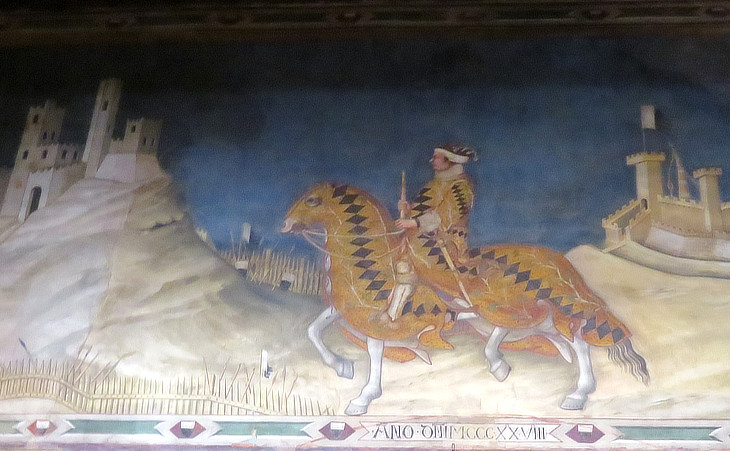
Palazzo Pubblico - Sala del Mappamondo: Guidoriccio at the Siege of Montemassi by Simone Martini (?)
I was marched through a number of vaulted halls and chambers, which, in the intervals of the administrative sessions held in them, are peopled only by the great mouldering archaic frescoes - anything but inanimate these even in their present ruin - that cover the walls and ceiling. (..) But one should speak of the Siennese painters gently - and I do, from my soul; for their labour, by their lights, has wrought a precious heritage of still-living colour and rich figure-peopled shadow for the echoing chambers of their old civic fortress. The faded frescoes cover the walls like quaintly-storied tapestries; in one way or another they cast their spell.
James
In 1328 Simone Martini painted in the Sala del Consilio a fresco representing the equestrian figure of Guidoriccio Fogliani de' Ricci, the victorious general of Montemassi and Sasso Forte. Sienna thus boasts at the present time of two frescos by Simone. He received for this fresco 16 florins. From the floor the figure, occupying the whole extent of the wall, appears of life size, and sits nobly on a well designed and well proportioned horse in the heavy panoply of the time. Crowe and Cavalcaselle
The portrait of Guidoriccio has since become an iconic image of medieval Italy, but the discovery in 1981 of the evidence of another fresco in the same hall, probably that for which Simone Martini was paid, led to problems of attribution with many art historians coming to the conclusion that the portrait of Guidoriccio is a work of a later century.
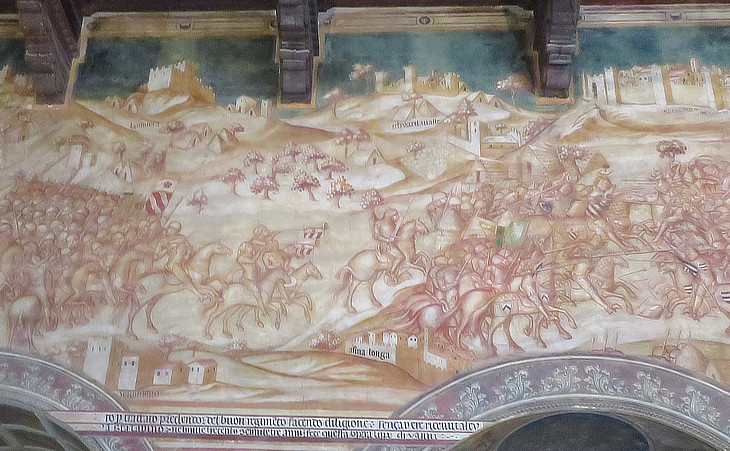
Palazzo Pubblico - Sala del Mappamondo: Battle of Torrita (1363) signed Lippo di Vanni
(April 1790)
As a school of early painting, Siena disputes precedency with Florence. (..) Many excellent specimens of early fresco paintings are dispersed about the city.
Richard Colt Hoare - A classical tour through Italy and Sicily - publ. in 1819
During the period of its freedom the territory of Siena was large and populous; 100,000 men were found within its walls; it had thirty-nine gates, of which all but eight are now closed; the arts were encouraged, the city became the seat of a school of painting, and its commerce was so extensive as to excite the jealousy even of the Florentines. Murray
Lippo Vanni is inscribed first on the list of the Siennese guild in 1355, and known as the author of miniatures and paintings of which the majority are lost. (..) He laboured with Nello Betti, in 1359 in the Sala del Consilio of the Palazzo Pubblico. Crowe and Cavalcaselle
The fresco shows with great evidence that the troops of Siena were led by a member of the Orsini family because several flags display the coat of arms of that family. The condottiere (commander) was Francesco Orsini of the Monterotondo branch of that family.
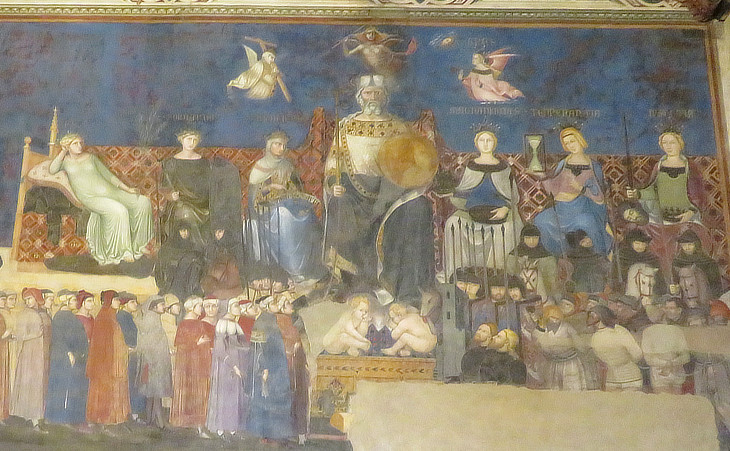
Palazzo Pubblico - Sala della Pace or delle Balestre: Il Buon Governo by Ambrogio Lorenzetti
The Sala delle Balestre is covered with frescoes by Ambrogio Lorenzetti (1338), illustrating the results of good and bad government. Murray
Early in 1337, and for two entire years afterwards, Ambrogio Lorenzetti was employed in adorning the Sala de' Nove or della Pace in the public Palace at Sienna with frescos which were completed on the eighteenth of Feb. 1339. (..) This colossal figure represents a man in the ripeness of age, with silvery hair and beard, a baronial cap on his head. (..) A mantle, white to the waist and black from that downwards, clothes the figure in the colours of the "Balzana" or shield of the Comune of Sienna, and is embroidered and fringed with gold. A shewolf giving suck to two babes and licking one of them with her tongue forms a footstool to the figure. Faith, Charity and Hope hover about the head of the "Comune". The majesty of Sienna is guarded by soldiers in armour to the right and left of the throne, standing on foot and on horseback, whilst in front of these, on the right foreground, is a group of captives.
The impression created by this ably distributed fresco is that which might be produced by the enlargement of a picture on an Etruscan vase, a pretty rather than a seriously grave character being peculiar to it. The arrangement of Wisdom, Justice, and Concord, is good and the highest degree of elegance and grace is combined in them. Crowe and Cavalcaselle
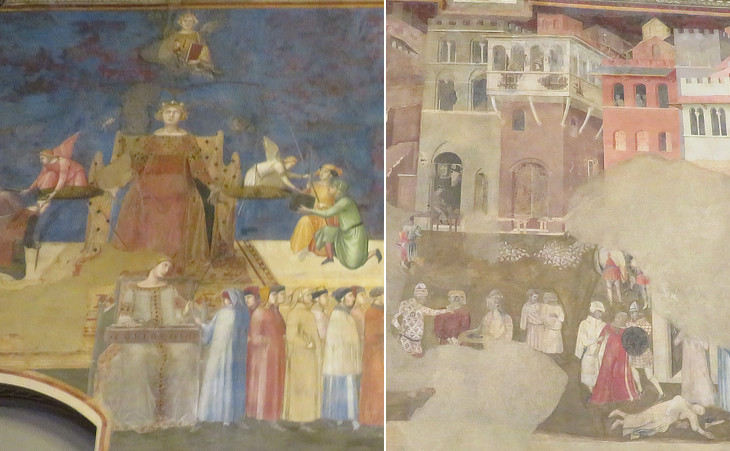
Palazzo Pubblico - Sala della Pace: (left) Allegoria del Buon Governo (detail); (right) Allegoria del Cattivo Governo (detail)
High up on the left hand, a half length figure of Wisdom, inscribed "Sapientia", crowned with a diadem and wearing a veil round its neck, hovers on the wing with a book in her left hand. She holds with her right the handle of a gigantic balance whose beam reposes on the head of Justice, looking up as if for inspiration to the figure of Wisdom, and poising at an equal height the disks. In that to the left a winged angel bends outward and decapitates a kneeling man, whilst with his right hand he places a crown on the head of another kneeling in prayer. This is distributive justice as the word "distributiva" indicates. A similar angel bends out of the disk to the right, dipping one hand into a box held by a kneeling person and giving a lance and sword to another in a similar attitude. This obscure allegory is explained by the inscription "Comutativa". Apart from the allegorical conception which was obviously studied and invented by the fancy of an unartistic mind, the figure of justice is one of the noblest and finest produced in the school of Sienna. It deserves indeed to be classed amongst the greatest creations of art of the time. A noble mien, supreme dignity, adorn the figure and sit on the brow of a youthful female whose mighty tresses are plaited out beneath a diadem, leaving the cheeks, the neck, free to display their rich and well filled forms. The face is soft in its foreshortened roundness, the features regular, and the high-waisted red dress richly embroidered in gold. No one after Giotto better or more artistically coupled dignity with elegance and grace; and if severe simplicity is not attained in the Florentine measure, it is that the Siennese were of a different stamp and spirit from their rivals. And now let us carefully trace the somewhat delicate thread of the allegory. A couple of lines pass from the waists of the angels in the disks. One is red, the other white. These lines fall and unite themselves in the left hand of "Concord", seated on a throne immediately beneath "Justice", a gentle figure crowned with a diadem, with a flame burning in its centre, and holding in its hand a carpenters plane inscribed with the word "Concordia". She passes the double line to a miniature personage standing near her, who hands it on to his neighbours, forming a long procession of twenty-four persons, advancing in couples. (..) The third wall (opposite the door) is devoted to a warning of the evils of a bad government. Much of this picture has perished. (..) The left half of the painting is meant to exhibit the effects of bad government, but a great part of the scene is obliterated. In the distance, the town appears in the same order as in the fresco of peace. Persons on a tower are throwing it down. Figures on the foreground lie dead, soldiers commit thefts, and the keepers at the gate rob an old woman of her fruit and vegetables. Crowe and Cavalcaselle.
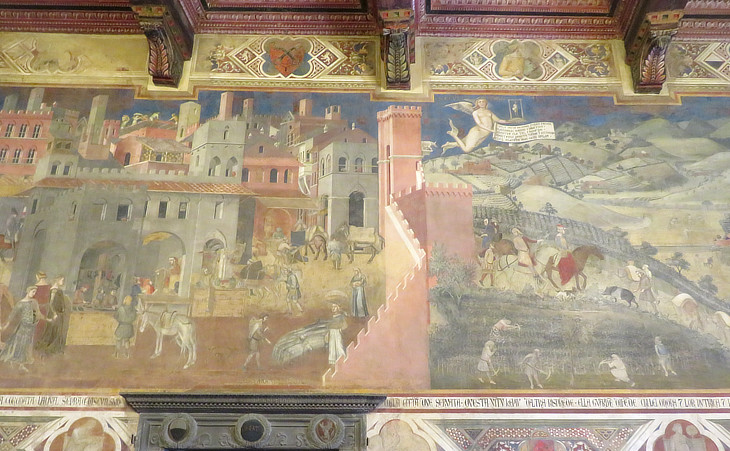
Palazzo Pubblico - Sala della Pace: Results of the Good Government
The results of a good government are illustrated on a second wall of the Sala by Ambrogio in a vast fresco representing the arts, the trades, the business and pleasures of Sienna. Divided into town and country by the profile of a wall and gate with a moat and drawbridge defended by a high square tower, and a barbican; on which the she-wolf and twins stand guard, the distance to the left is filled with houses, with towers in one of which workmen are busy, with the belfry and dome of the cathedral. People of both sexes stream in at the gate with provisions on sumpter mules, with goats and cows. It is a glimpse of public life in the fourteenth century. (..) On the left a lady and gentleman on horseback are followed by an attendant, carrying flowers. Another couple of the same kind have issued from the gate into the country on the right, followed by a page. The man carries a hawk. (..) Peaceful pleasure in town and country, trade and traffick undisturbed declare the prevalence and consequent prosperity of peace. A youthful genius of a beautiful shape flies by the side of the entrance tower, veiled in part and inscribed "Securitas". The whole of this wall has been injured more than the first one, and damp has removed some of the colour, whilst in other parts the intonaco has fallen out or repainting has taken place. The landscape to the right is in fact new. Crowe and Cavalcaselle.
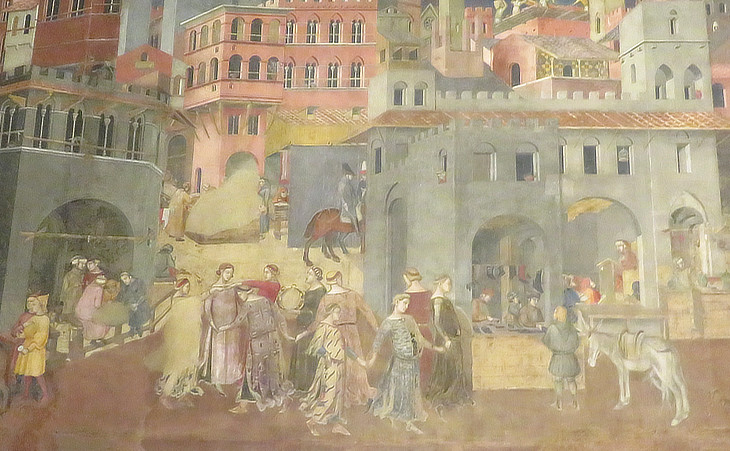
Palazzo Pubblico - Sala della Pace: Results of the Good Goverment (detail)
In a shop, a tailor makes and sells clothes, the teacher at his desk presides over a class, whilst other children play. In the middle of the foreground ten girls, in pretty head dresses and closely fitting costume, dance in a circle, passing under the arms of two whose hands are joined together, all to the sound of one singing and striking a timbrel. Elegance, elasticity, motion are well rendered by the painter. Crowe and Cavalcaselle.
The results of the good government of Siena were still felt centuries after the fresco by Lorenzetti. Many travellers were happy about their stay at Siena and recommended the town.
It is vulgarly and truely said, that Sienna abounds with
Fountaines, Towers, and faire Weomen: There is no
better place to live in through all Italy, then the state
of Florence, and more specially the most sweet City of
Sienna. (..) Sienna is commended for the best language,
and in the same, and in all the state of Florence, men
live safe from robberies, and from the murthers, which
are frequent in Lombardy. Adde that they have delicate
diet, at Florence at a reasonable rate, and in the rest of
the territory at a very cheape rate. Our Hostesse at
Sienna gave us cleane linnen often changed both at bed
and boord, a large chamber, a good bed, a linnen canopy
oft changed, and did provide our meat very cleanly;
for which each man paid no more then ten giulii by the
month. (..) The Citizens of Siena are most curteous, and
they have many publike meetings of the young weomen
& Virgines to dance, where the doore is open for any
Citizen or stranger. Moryson
This City is counted a very good place to sojourn in for a Stranger that would learn Italian as well because the Citizens heer speak the purest language, as for that they are very civil and courteous to Foreigners. Besides by reason of its situation the air is temperate even in Summer time. Provisions also are reasonable. Ray
Sienna is an university, pretty much frequented by foreigners, especially Germans, who enjoy several privileges. The academy for young gentlemen to learn their exercises is under the direction of the Jesuits who have a handsome college. The town is also famous for the purity of the Italian tongue, which is spoken here without that guttural pronunciation, so disagreeable in the Florentines. For this reason a great many foreigners chuse to reside here some time to learn the language, rather than at Florence where it is badly pronounced, or at Rome where there is too much hurry and noise, because of the multitudes of strangers, with whom you are daily obliged to converse. Nugent
In many respects Siena has claims superior to any other town in Italy, particularly as an eligible summer residence. Its situation amongst the Apennines is airy and healthy; the heat of its climate even in the midst of summer, is not oppressive: its society is agreeable and unaffected; and the purity of its language and accent is generally allowed to surpass that of any other province. It becomes, therefore, a most desirable residence for those who wish to be instructed in the language of the country, and who are desirous of avoiding the oppressive heats of Florence, the pestilential vapours of the Campagna, and the musquitos of Naples. Colt Hoare
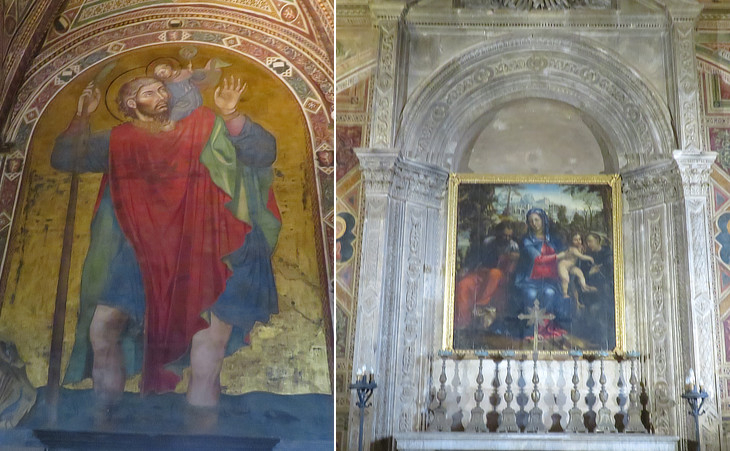
Palazzo Pubblico: (left) St. Cristopher by Taddeo di Bartolo in the Ante-chapel; (right) altar with a painting by il Sodoma in the Chapel
The adjoining Chapel is covered with very graceful and expressive frescoes, illustrating the history of the Virgin, by Taddeo Bartolo; the altarpiece of the Holy Family and S. Calisto is by Sodoma. Murray
In August 1406, it was resolved in council that Taddeo di Bartolo should be employed to repaint the chapel of the Palazzo Comune at Sienna. A special deliberation took place to consider the question of ways and means, and the artist was authorized to destroy all the paintings previously existing in the chapel. He began in September. In lunettes, and on numerous arches , he decorated the spaces with medallions inclosing allegorical figures of Fortitude, Prudence, Faith, Hope, Charity, prophets, the four evangelists and the four doctors of the church. In the archivolts of the entrances he placed busts of saints, and the arms of the comune and people. (..) So great was the impatience of the council to see all this finished, that on the 10th of November; scarcely five weeks having elapsed since Taddeo had commenced, he was informed that the whole must be ready before December under a penalty of 25 florins. On the 16th of November, in order to make assurance doubly sure, the council resolved that he should not leave the chapel before the completion of its decoration, and pressed by his employers in this extraordinary and unusual manner, he succeeded in finishing the work to their satisfaction.
Whilst arbiters settled the price that Taddeo was to receive, the hall of the chapel remained to be decorated; and the artist was ordered on the 8th of January 1407 - to paint the S. Christopher. For this, which was finished with the usual speed, Taddeo received 33 florins for colours, gold and the payment of his apprentices. Crowe and Cavalcaselle.
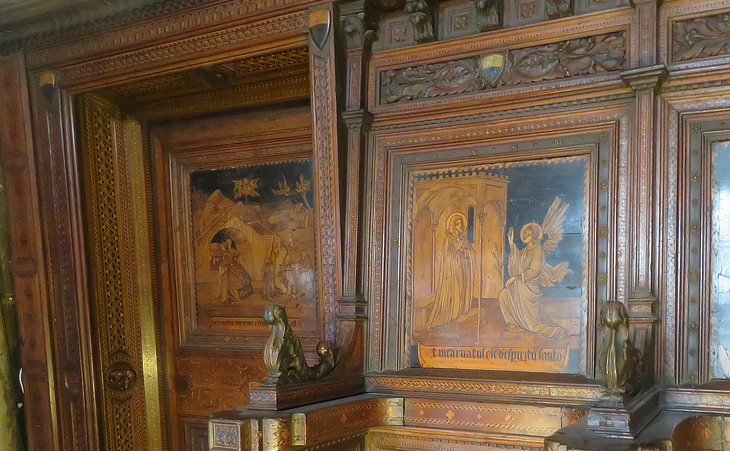
Palazzo Pubblico - Chapel: "tarsia" (wood inlay) depicting the Annunciation with a sentence from the Creed "Et incarnatus est de Spiritu Sancto" by Domenico di Niccol˛ (1429)
In the XIVth century Siena saw the development of a school of wood inlayers whose works were requested also by other towns. Orvieto retains an elaborate lectern which was made for the Cathedral. Many other tarsia are lost and the stalls of the chapel of Palazzo Pubblico are the remaining finest example of this tradition at Siena.
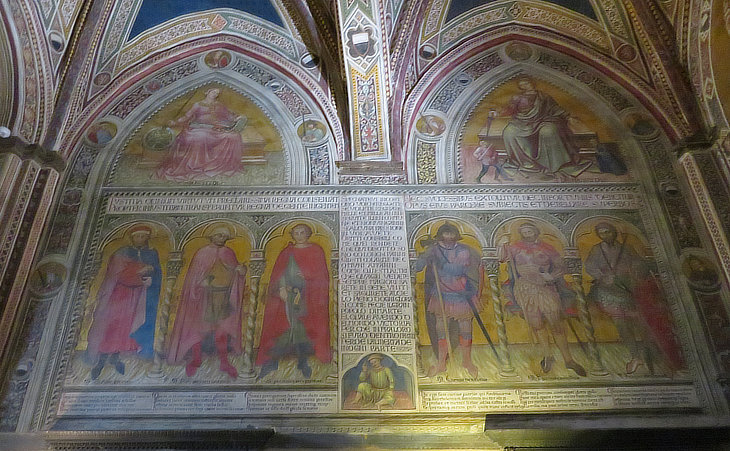
Palazzo Pubblico - Ante-chapel: Virtues and Roman heroes by Taddeo di Bartolo
The adjoining room has a curious gallery of portraits of illustrious persons, republicans and others, among whom Cicero, Cato, heathen gods, aud warriors, are found ranged with Judas Maccabeus and St. Ambrose; they are also by Taddeo Bartolo (1414). Murray
The rest of the hall was not commissioned of him till Oct. 9th 1413, and the payment of 78 liv. 16 sol. for that portion of the work was made in June 1414. There, on a wall facing the altar and visible through the colonnade which separated it from the hall, Taddeo placed figures of such heroes of the olden time as might have been celebrated for the qualities of magnanimity, Scipio Africanus, Furius Dentatus, Marcus Curius Dentatus. These were made to stand erect in niches and in Roman costume; and in the lunette above, Magnanimity, allegorically symbolized the virtue assigned to them. In the next compartment, Scipio Nasica, M. Portius Cato and Marcus Tullius Cicero were placed in similar niches, above which a figure symbolized Justice. Beneath Cicero the grammarians of Sienna placed an inscription, calling upon the spectator to imitate these virtues, (..) Taddeo's art being intended to convey lessons to those who on entering might possibly be induced to forget that Magnanimity and Justice both preside over verdicts. Crowe and Cavalcaselle.
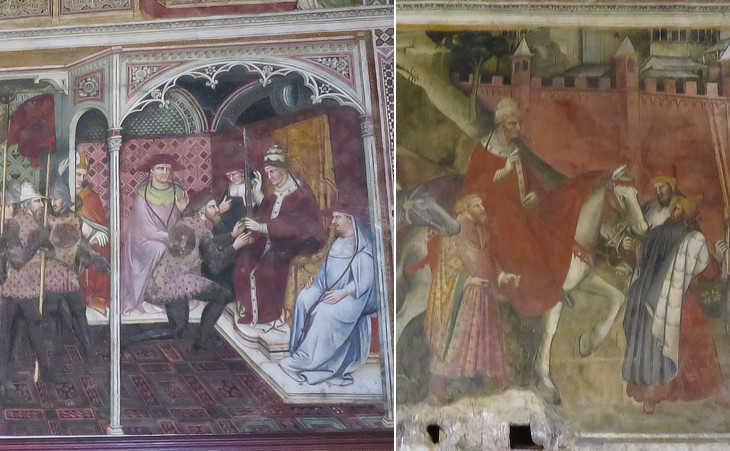
Palazzo Pubblico - Hall of Pope Alexander III: frescoes by Spinello Aretino (1408): (left) Sebastiano Zani, Doge of Venice and the Pope; (right) the Pope on horseback led by Emperor Frederick Barbarossa into Rome (see another fresco by Spinello at Arezzo)
The paintings of Spinello Aretino are also remarkable: they represent the leading facts in the history of Frederick Barbarossa and Alexander III., from their first election to the triumph of the pope over the emperor, and their final reconciliation. Murray
In March 1408 Spinello returned to his old quarters at Sienna with Parri, to execute the frescos of the Sala di Balia in the public palace, in conjunction with Martino Bartolommei, who decorated the ceiling and framework with festoons and allegorical figures of little value. Here Spinello illustrated in sixteen parts the animated story of the Venetian campaign against Frederick Barbarossa, interesting to the Siennese from the share which legendary history assigns in it to Rolando Bandinelli promoted to the pontificate under the name of Alexander the Third. Executed with great dexterity and freedom, and more than usually successful in composition, these frescos are the best that remain to us of Spinello. The whole of the chapel with its waggon roof is adorned with paintings. (..) The best maintained of these frescos is that of Zani before Alexander, the most animated and best arranged that of the Pope on horseback led by Barbarossa; and the figures on horseback as well as the horses themselves are fine and fairly in motion. Crowe and Cavalcaselle.
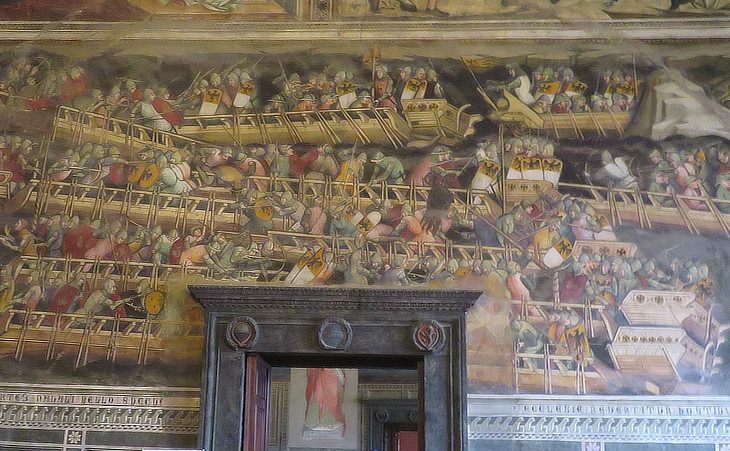
Palazzo Pubblico - Hall of Pope Alexander III: naval battle of Punta Salvore (1177 - near Trieste) between the Venetian fleet which supported the Pope and those of Pisa and Genoa which supported the Emperor
Above the entrance a naval encounter is represented, over which two lunettes contain smaller compositions. (..) Though all the scenes are not equally well distributed, and the defective form and perspective of the architecture makes planes oblique which should be horizontal, still the general impression is favorable because of the excessive speed and boldness of the execution, a comparatively fair breadth of light and shade, gay, vigorous and transparent colour, sweeping drapery and a general aspect of life and motion. There is in fact a decorative unity in the whole which is effective. But there is still much to reprove in the drawing of the hands, feet and articulations, and in that of many short and thickset figures. Colour seems to have been obtained by simple means, first of all by systematic rapidity of hand, and then by the use of white undergrounds for high flesh lights, warmed up with transparent glazes. The share of Parri in these labours is evidently secondary: because all the frescos are by one hand and in one characteristic style. Crowe and Cavalcaselle
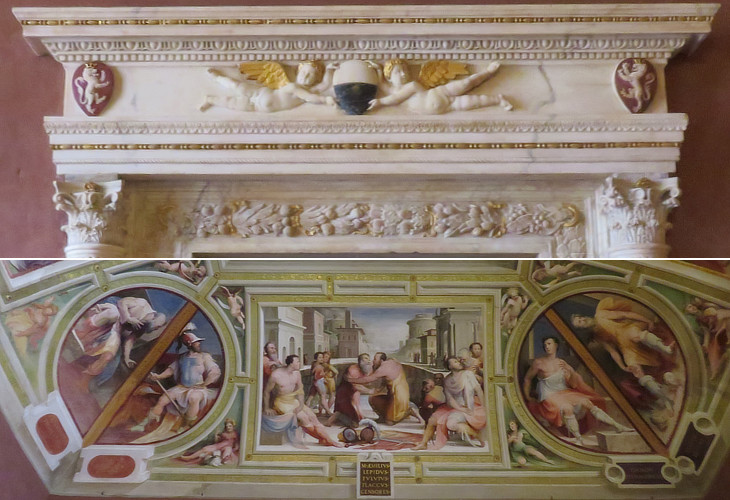
Palazzo Pubblico - Sala del Concistoro: (above) 1446 portal by Bernardo Rossellino who designed Palazzo delle Papesse at Siena; (below) frescoes by Domenico Beccafumi aka il Meccarino
Domenico was recognized as a rare painter by those who were then governing, and was commissioned to paint the vaulting of a hall in the Palace of the Signori, to which he devoted all the diligence, study, and effort of which any man is capable, in order to prove his worth and to adorn that celebrated building of his native city, which was honouring him so much. This hall, which is two squares long and one square wide, has the ceiling made not with lunettes, but after the manner of a groined vaulting; wherefore Domenico executed the compartments in painting, thinking that this would give the best result, with friezes and cornices overlaid with gold, and all so beautifully, that, without any stucco-work or other ornaments, they are so well painted and so graceful that they appear to be really in relief.
Giorgio Vasari - Lives of the most eminent painters, sculptors & architects - transl. by Gaston Du C. De Vere
The whole fabric was shaken by the earthquake of 1797, which cracked all the frescoes of Meccarino in the Sala del Consistorio, damaged half the palaces in the city, and frightened the late pope out of it. Forsyth
The ceiling of one of the halls in the palace of the municipality is decorated by this artist, but show him to less advantage in his gay colouring than he appears on the pavement of the cathedral (it opens in another window). Peale
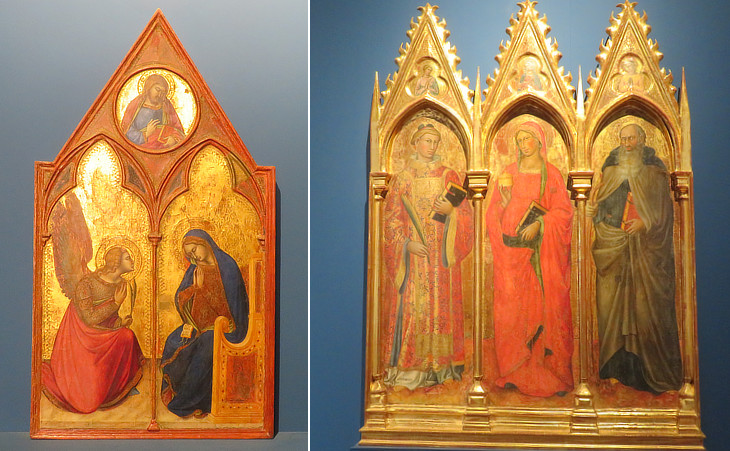
Palazzo Pubblico - Museo Civico: (left) Annunciation by Niccolo di Ser Sozzo (records in 1334-1363); (right) St. Stephen, St. Mary Magdalene and St. Anthony the Abbot by Martino Bartolommei (1408) who worked with Spinello Aretino
The painters of Siena had, one should think, before their eyes the Siculo Byzantine examples, whose studied and careful execution, whose minute precision of drawing and detail, whose powerful and lively colour and elegant ornament were greatly to be admired. They succeeded in rivalling these models, carrying ornamentation beyond an accessory and making it a principal feature in their pictures. They pursued this path so far that, not merely their draperies, but a nimbus, a gilt background, and the frame which enlivened the composition, were stamped with the most exquisite designs of leaves and branches, with human heads for flowers, or arabesques of a more general form, relieved, coloured and gilt, with all the delicacy of a tasteful oriental style. (..) The reason is to be found in their fondness for ornament which required time and trouble to work out. (..) A Florentine altarpiece might be seen at a greater distance, a Siennese panel invited closer attention; but, for this very cause, it demanded more minute finish and more time. Crowe and Cavalcaselle
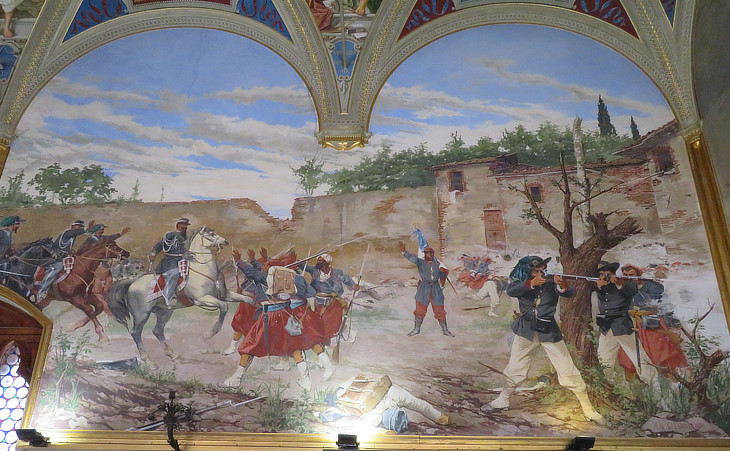
Palazzo Pubblico - Sala Vittorio Emanuele II - Battle of Palestro by Amos Cassioli (an episode of the Second War of Independence in 1859)
Move to:
From Porta Camollia to S. Domenico
Cathedral - The Building (to be developed)
Cathedral - Interior (to be developed)
Opera del Duomo (to be developed)
S. Maria della Scala (to be developed)

